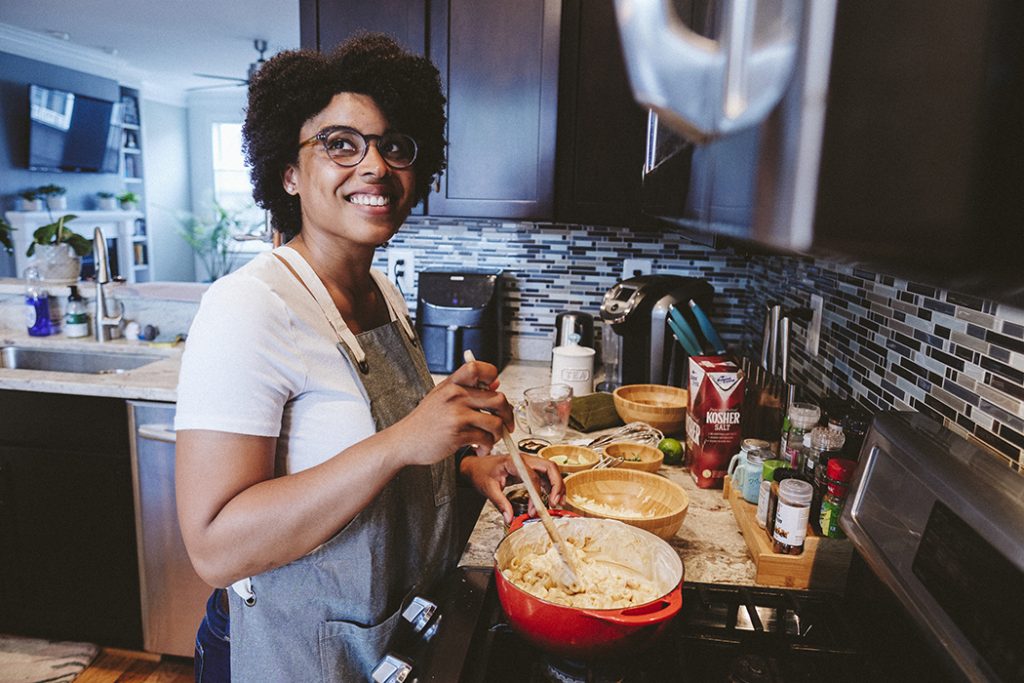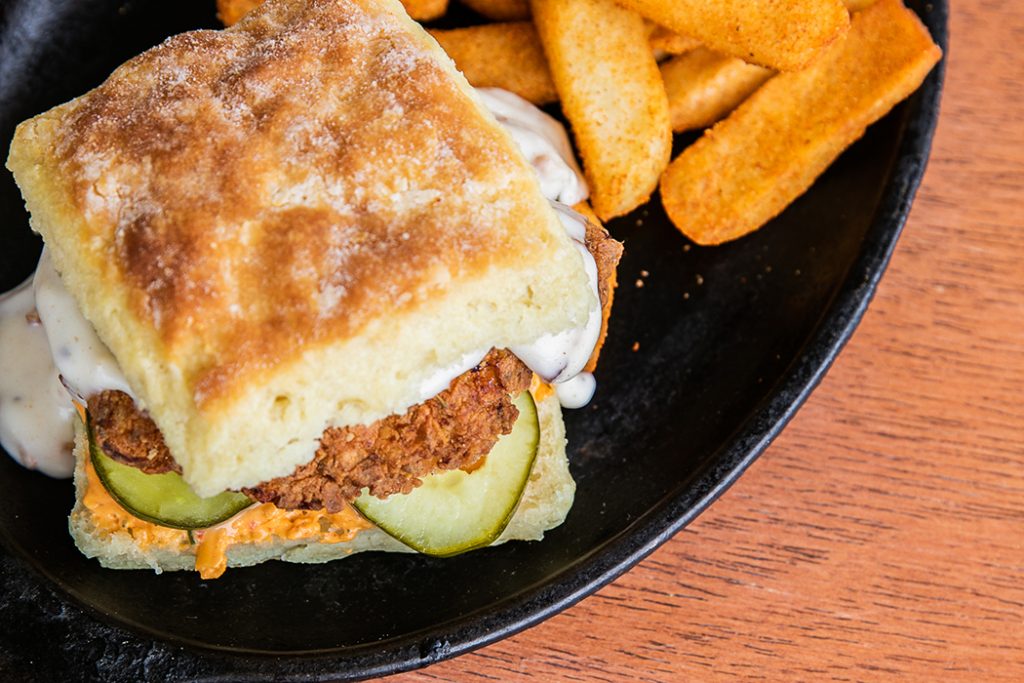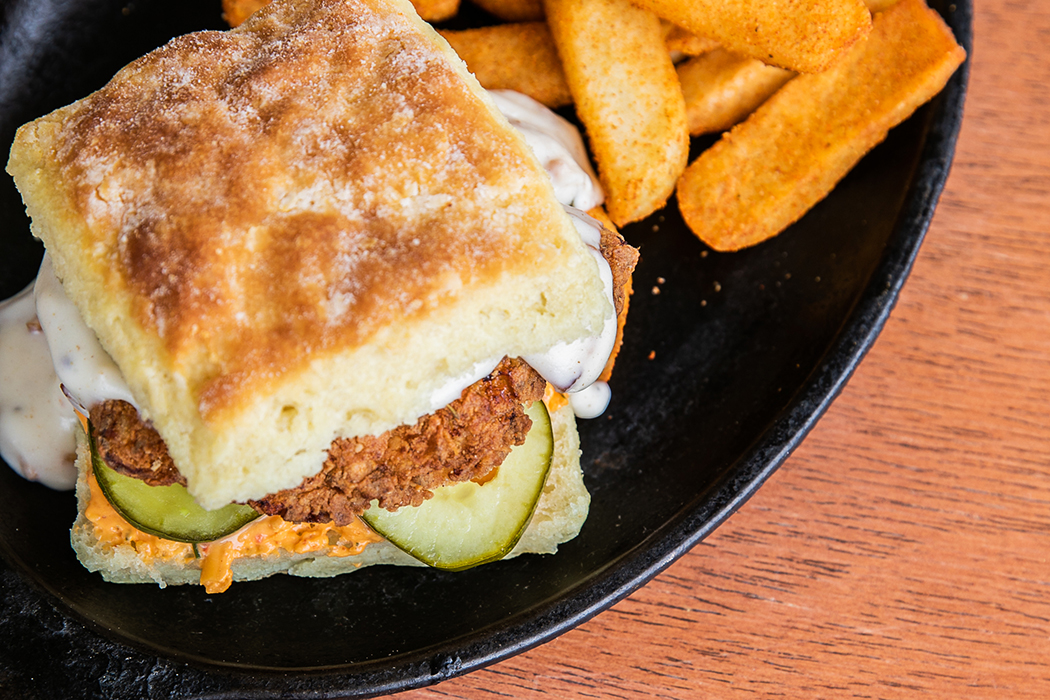Vast culinary traditions influence Southern food—European, Native American, African, Caribbean. But if you’re thinking individually about those traditions when you’re thinking about Southern food, you’re kind of doing it wrong, according to food historian Leni Sorensen. Those traditions hit American soil in the 1600s and immediately began to mingle, even as they traveled south, she says.
“It happened fast, and it began to happen much earlier than it is ordinarily supposed to,” says Sorensen. “In the last quarter of the 17th century is when it begins to accelerate.”
The result in the American South was a European cooking tradition—staples from Great Britain tinged with French influences—vastly transformed by the indigenous and enslaved people of the New World. Where chefs in Europe may have had luxurious ingredients, clever cooks stateside had to coax flavors out of what the land provided, using seasoning (think plenty of fat and salt) and technique (think low-and-slow transformations).
“Southern food is indigenous food,” says Ryan Hubbard, owner of Red Hub Food Co. “Southern food is not filets or T-bones or rib eyes…It captures more the cuts of meat you weren’t used to seeing.”
The history of the American South also led to a rapid alignment of Southern food into regions, Sorensen says. Just as quickly as the cuisine’s worldwide influences coalesced in the States, the influences redistributed with subtle differences into the Old South, Mid-South, Gulf Coast, and other sub-regions.
“That’s what makes it exciting,” Sorensen says. “You can go 200 or 300 miles, and you are in a different world.”
The regionalism sprung naturally from the different growing regions present across the South, says Sorensen, but it was also due to the new nation’s “immense peripatetic population.”
“Different groups and families were moving and looking for new land,” she says. “You had that tremendous exodus of the slave trade out of the Old South and eastern coastline. In one decade, 350,000 black Virginians were sold to the rest of the Southern slave states.”
Nevertheless, Sorensen says four ingredients anchor Southern food: corn, rice, greens, and pork. Take hush puppies, one of Red Hub’s most popular menu items. Hubbard points to the Native American influence in the corn and the deep-frying tradition of Scotland coming together to make an inexpensive, humble dish found throughout the South.
Today, Sorensen says Southern cooking is enjoying newfound respect in culinary circles. But where does Charlottesville fit in the Southern culinary tradition? According to Sorensen, central Virginia lacks a specific focus because of its many bounties.
“Part of what it was known for was its fecundity,” she says. “We were a breadbasket and an apple basket…we were really producers—food that was transported to a lot of other places.”
Southern (con)fusion
New Southern cuisine is like putting ranch dressing on pizza. Everyone’s doing it, but no one admits to it.
“When we set out to do Whiskey Jar, we specifically were not trying to be ‘new Southern,’” local restaurateur Will Richey says. “We might make some tweaks in the new Southern vein, but I still say we are classically Southern.”
So what is new Southern? The South Carolina Encyclopedia defines it as “a culinary trend that developed during the final three decades of the twentieth century in the American South [when] a new affluence provided the climate to experiment with new foods or prepare traditional fare in new ways.” The University of South Carolina-driven wiki cites grits made with milk, cream, or broth instead of water as an example.
According to Richey, new Southern is all about the extent of experimentation. Vinegar-based coleslaw instead of the traditional mayo base? Southern. Slaw with jicama and avocado? New Southern. Indeed, Richey says the easiest way to spot a new Southern dish is to look for Californian influence. Since Southern cuisine has long relied on farm-fresh produce, Cali’s 1970s-era farm-to-table movement fit right in.
So where does one find a new Southern supper in C’ville? Harrison Keevil’s Brookville was once the standard-bearer, Richey says, but since the restaurant closed in 2016, the genre has been underrepresented. “Maybe Ian Boden at The Shack, because he is so hyper-local in his sourcing,” Richey says.—Shea Gibbs

Kicking up a classic
Coming soon: Mac and cheese, with a twist
What’s not to love about mac and cheese? According to Sherry Bryant, whose dream of opening a restaurant dedicated to the gooey comfort food is approaching reality: basically nothing.
Elbows, a mac and cheese-focused virtual restaurant, started back in Bryant’s childhood home, where her family prepared a lot of Southern comfort foods, and she’d help in the kitchen.
“One of my favorite dishes to eat and make was macaroni and cheese,” Bryant says. “The entire process was just so consuming and…fun. From stirring the roux and slowly adding in milk for the bechamel sauce, to experimenting with blending different cheeses to alter flavor in subtle ways, to the sound of stirring in elbow noodles to cheese sauce, and spooning cheesy heaps of goodness into a bowl. Magical.”
Cut to a trip to Manhattan, when Bryant stumbled into S’MAC in the East Village. A tiny hole-in-the-wall spot, it was dedicated to her favorite food, plus add-ins. She was smitten. She was inspired.
She’s spent the last several years—and spare moments between her full-time middle school teaching job—cultivating the concept of gourmet macaroni and cheese and pitching it to willing ears and mouths. As of this writing, she had applied for commercial kitchen space with Bread & Roses, which would allow her to partner with delivery services to get her mac bowls to customers.
But let’s get down to the nitty-gritty (ooey-gooey?): the flavors. A fan favorite so far is the Chorizo Mac—creamy Jack cheese, smoked chorizo, and chipotle adobo topped with cilantro and a squeeze of lime—and she’s currently workshopping a Cajun-influenced dished, trying to strike a balance between spicy andouille and a mellow cheese like fontina. But Bryant’s personal preference is for the Pesto Mac: wide elbows tossed in basil pesto, pecorino romano, and topped with mozzarella pearls and ripe cherry tomatoes.
“It’s just the right combination of nutty, herbaceous, and salty,” she says.
“The driving force behind Elbows is taking a dish that is so comforting and familiar and making it fresh,” she says. “That’s at the core of the sort of restaurant that Elbows will be—super approachable, but also exciting!”—Caite Hamilton

Southern made simple
These four spots set the standard for down-home dining ’round these parts
When you feel like all these newfangled Southern restaurants are putting the fusion in confusion, you know where to turn: the diners and lunch counters where the flattop’s been sizzling since your mama was in short pants. The standbys where the menu reads like a 1955 edition of Southern Living: collard greens, fried chicken, mashed taters, gravy, coleslaw, burgers. No gimmicks, no tricks.
“I’ve been here for 30-some years,” says Mel Walker of Mel’s Cafe on West Main Street. “The whole Charlottesville community done changed. When I first opened up, it was all Black businesses in an all-Black neighborhood.”
Thank the good lord places like Mel’s tune out the noise and stick to their roots.
Moose’s By the Creek
With taxidermy lining the walls and offhand firearm humor, Moose’s in Belmont does its own thing and does it well. Come for the breakfast—country ham and eggs with home fries and a biscuit should suit—and stay for a Classic Creek burger with a side of mashed potatoes, green beans, potato salad, coleslaw, or mac and cheese. It’s a veritable who’s who of southern sides and savories. 1710 Monticello Rd.
Mel’s Cafe
Even if his neighborhood’s flipped upside down over the last three decades, Walker still loves what he does. “I don’t know if I’m crazy or what,” he says. “I just love the restaurant business. I’m still enjoying myself.”
The choice at Mel’s? Despite the extensive menu, it’s easy. Fried chicken. Still made the same way Walker started making it last millennium, and still delicious. “We are basically home-cooked Southern food,” Walker says. Sometimes that’s all it takes. 719 W. Main St.
Fox’s Cafe
Fox’s Cafe on Avon Street has two words and one contraction for ya: biscuits ‘n’ gravy. Biscuits as in from-scratch buttery rounds. And gravy as in homemade sausage.
Owned and operated by Diane Fox since it opened, Fox’s also does right by dinner as well, with fried bologna sandwiches, liver and onions, and hamburger steaks hot from the grill. 403 Avon St.
Croby’s Urban Viddles
Croby’s has only been slinging the Southern in C’ville since 2016, but it’s an old soul. Owned by Shannon and Rob Campbell and Mike Marcinek, Croby’s is named for the former’s dad and focused on scratch cooking family recipes.
Oh, and Croby’s ain’t afraid to mash up traditional ingredients in funky ways. Check out the Hot Mess Muffins next time you happen by—sweet cornbread topped with pulled pork and chicken, pimento cheese sauce, and a barbecue sauce drizzle. It’s all the Southern staples on a spoon. 32 Mill Creek Dr. #102—SG

Excellence on a plate
The Ridley honors a UVA trailblazer with top-notch Southern fare
In 1953, the late Dr. Walter N. Ridley earned a doctorate in education from the University of Virginia—the first Black American to receive a Ph.D. from a traditional white Southern college. The Ridley, the new Black-owned restaurant at the Draftsman Hotel (1106 W. Main St.), honors Ridley’s legacy by giving traditional Southern cuisine a high-end twist.
“We really have worked hard to bring our interpretation of Southern cuisine to life,” says co-founder Warren Thompson, a Darden School grad and CEO of restaurant group Thompson Hospitality, “elevating expected offerings like shrimp and grits, deviled eggs, fried green tomatoes, and cornbread, and adding completely unexpected dishes like our fried lobster tails and duck and dumplings.”
The Ridley’s menu focuses heavily on seafood—Thompson sings the praises of the Chilean sea bass, covered with Thai broth tableside just before it’s served—and at least 5 percent of its annual profits will be donated to UVA’s Ridley Scholarship Fund.—Nathan Alderman

Spin doctors
Twisted Biscuits food truck offers a new take on tasty traditions
Hayley Tew and Ian Judd knew their new food truck needed some kind of twist. They hit upon the name and the concept simultaneously: Twisted Biscuits, where classic biscuit sandwiches get a fresh presentation. From breakfast standbys, to lunch offerings like the Green Gobbler or the Fig Pig, to specials like bacon-gravy poutine, Tew and Judd bring serious culinary firepower to bear on the humble biscuit.
Both Twisted Biscuit founders have been working in professional kitchens since their high school years, with a combined resume that includes The Clifton, the Ivy Inn, and BBQ Exchange. “We’d always talked about having our own business,” Tew said. “When the pandemic hit, we found ourselves with an uncertain future and a lot more down time.”
Like a boost of baking powder, this gave them the kick they needed to start their rise. In November 2020, they launched their food truck—and promptly found themselves all but buried in biscuits.
“We do 80 to 200 biscuits a day,” Tew says—that’s anywhere from five to 20 pounds of flour every day, all day, right on the truck. They often need to turn out more trays to meet demand for favorites like the pimento cheese and bacon gravy-slathered Dirty Bird, featuring their hand-breaded and brined fried chicken.
Beyond their usual offerings, the Twisted Biscuits twosome likes to experiment with playful seasonal additions, from “pupsicles” for canine customers (Tew and Judd have three dogs at home) to biscuit-crumb crab cakes on cheddar-chive Old Bay biscuits for Valentine’s Day.
While Tew says they’re open to operating a stationary location in the future, for now you’ll have to stay on the go to score their fare. You can track them on Facebook or Instagram at @twistedbiscuittruck—or just follow the aroma of fresh-baked biscuits.—NA
